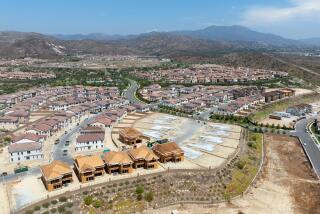Irvine Tornado One of a Rare Breed in O.C.
- Share via
Ask your neighbor. Or your oldest aunt. They’ll tell you: If you want to see a tornado, go to Kansas. Or maybe Ohio.
Certainly, not Orange County.
But as the more cynical will warn, the only thing that’s predictable about weather is that it’s unpredictable.
Ask any of the dozens of Irvine residents who left their otherwise serene Orange Tree neighborhood Thursday morning. They returned to find a landscape reshaped by what must have seemed like a meteorological Rototiller.
At 12:45 p.m., a tornado as ominous as the pitch-black twister that clanged Dorothy into the Land of Oz smacked nearly 50 Irvine homes, ripping up roofs and uprooting trees. And putting another lie to the myth that the only natural disasters in these parts are earthquakes, brush fires and mudslides.
“This is something out of Iowa or Kansas,” said 63-year-old Jim Sleeper, Orange County’s pre-eminent historian.
According to Sleeper’s math, tornadoes are apt to strike some part of Orange County about once every five years.
“Blow off a few roof tiles, that’s what they usually do,” Sleeper said.
Except, of course, for April 5, 1924. On that day, a tornado pounced on a gaggle of oil wells that lined the sands of Huntington Beach, tearing up a few derricks, Sleeper said.
Before Thursday, the most recent confirmed twister to strike Orange County landed in Santa Ana on Jan. 31, 1979. That tornado did considerable damage along Main Street, wrecking a pottery shop and smashing plate-glass windows.
“The reason it normally doesn’t happen is, there usually isn’t a strong enough moisture source, a strong enough storm from the Pacific,” said Stephen P. Burback, a meteorologist for WeatherData Inc. “You need a nice cold air pocket that comes in from the north.”
Why then, did part of Irvine get hammered on Thursday?
“This was a funny little storm, where the (Pacific) front turned around and curled up toward L.A.,” said Earl J. Seagars, an instructor of marine weather at Orange Coast College and at USC.
As Seagars and other experts explain, tornadoes in the greater Los Angeles basin typically can’t exist without three things: Rising, unstable air; a cold, low-pressure system in the upper atmosphere, and southerly winds in the lower atmosphere that are deflected by coastal hills or mountains.
Meteorologist Michael R. Smith of WeatherData Inc. said those fundamental conditions existed Thursday, with these additional nuances:
The still-lingering storm is a strong, cold low-pressure system in the upper atmosphere that destabilized shafts of air below it on Thursday, causing that air to rise. The collision of the rising air with the colder air aloft caused several thunderstorms over Southern California to twist, counterclockwise. The capper was a southerly wind, deflected by coastal hills south and east of Irvine that speeded the counterclockwise rotation.
“It all works together,” Smith said.
Smith and one of his colleagues also pointed out that tornadoes in Southern California are not as rare as some would believe.
According to Smith’s data, 29 tornadoes struck the Los Angeles area from 1963 through 1982. On Nov. 9, 1982, he said, seven tornadoes were sighted. On March 1, 1983, a tornado tore through an area about a mile south of downtown Los Angeles, damaging 50 homes and seven businesses, Smith said. In fact, Smith said, he believes that more tornadoes--eight--struck Los Angeles during the winter of 1982-1983 than any other major metropolitan area.
More to Read
Sign up for Essential California
The most important California stories and recommendations in your inbox every morning.
You may occasionally receive promotional content from the Los Angeles Times.














